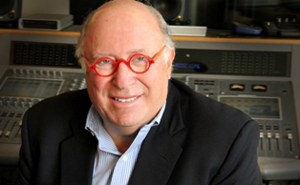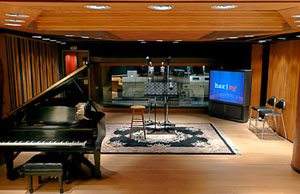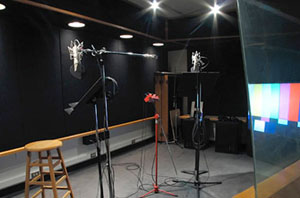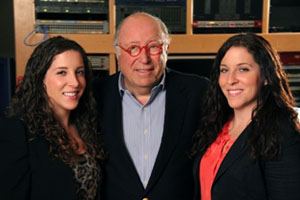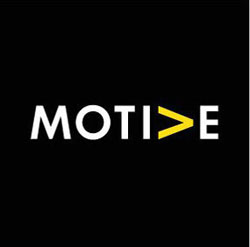May The Schwartz Be With You: Business Insights from An Icon of Audio Post
Midtown Manhattan: NYC audio icon Howard “Howie” Schwartz has a perspective on the NYC audio and post-production landscape that spans nearly four decades. He’s certainly spent enough time behind a mixing desk, built enough rooms, expanded, upgraded, re-tooled and kept his business growing for enough years to be able now, on the 35th anniversary of his Howard Schwartz Recording (hsr|ny), to tell it like it really is. And we are all ears.
“I don’t think it’s ever been as crazy as it is now,” Schwartz says of the competition and cutbacks in what has been his traditional audio post-production business. “We tried to stay ‘just audio’ for as long as we could but audio has been commoditized and now — since we have the real estate and the technology — we’re going off into other worlds, we’re diversifying again.”
By other worlds, Schwartz is referring to video, and to becoming a full-service post facility for his advertising and increasingly television and feature film clientele. Having expanded with 12 offline/online (video) editing rooms a couple years back, hsr|ny is now truly an audio and video post-production house.
We are sitting in one of the ten audio studios at hsr|ny which occupies 20,000-square-feet of the Graybar building at Grand Central. This place is massive, and most all of the rooms are cranking on the morning of our visit. In addition to the regular VO/mix and editing sessions going on throughout the facility, DreamWorks has booked Studio West with a very high-profile actor coming in to record dialog for a major animated feature. [Fun fact: this studio hosted The Rolling Stones mixing Tatoo You with Bob Clearmountain, and Foreigner 4 sessions!]
At 35, hsr|ny is entering a new era of business, driven by a new generation of Schwartz. Howie’s twin daughters — Zoe and Alexa — have stepped up into expanded roles in 2010, as director of sales and marketing and director of client relations, respectively. With a lifetime of exposure to the family business and dad’s wit and wisdom, they form a super-savvy biz dev tag team…Wonder twin powers, activate!
And what is their credo? We’re sure there is some enduring core ideal that can be traced back to the beginning, some principle that’s guided Howie through all the ups and downs, the cycles and trends of all the industries he’s serviced. And that’s what we’re here to discover.
“We were always in the business of selling time and the engineer’s expertise and artistry,” says Schwartz. “My concept was to create a place for everyone to do the best work they can do, to be successful, to be great. I provided a forum, gave people the opportunity to do something they could not afford to do on their own.
“I was also always true to the spirit of audio and the craft. I am an audio guy, I am a musician. So people felt at home — it wasn’t a corporate guy that was running this place. We’re all artisans here.”
Advances in computer-based systems and Pro Tools have changed the game, but still — as Schwartz puts it — “nobody really wants to go to someone’s home studio to make a recording for an American Express commercial.”
True that. But we are living and working in unprecedented times for audio production and post-production. Like the record business, the advertising and film industries aren’t producing the volume of big-budget work they once did. And for its size and scope, its record and reputation, hsr|ny has been the go-to for that narrowing piece of the pie. Advertising budgets, for example, are now meant to cover not only broadcast creative but also web and interactive campaigns, which in some cases means fewer commercials. But that’s not all…
“The big change in the audio business and even the video business is that a lot of the major advertising agencies have built in-house editing and audio post-production facilities,” says Schwartz. “So instead of having outside suppliers like us provide high-end recording/mixing and editing expertise, they’re handling a lot of that business themselves. This meant we needed to move in another direction. The writing was on the wall — why and how are we going to compete with all the other people going after the advertising money?”
History Repeating…
Of course, Schwartz hasn’t been in business for 35 years because of any one client or even any one industry. “I wanted to be in this building because J. Walter Thompson was here and had been my biggest client in my previous studio,” Schwartz recalls, as he walks us through the first two original hsr studios. “But they basically never showed up. Although,” he points out [fun fact], “they did record the original ‘I Don’t Want to Grow Up’ jingle for Toys ‘R’ Us here.”
The first of several Howard Schwartz Recording studios designed by John Storyk, Studio A was built in 1975 for music and radio spots. Schwartz had been a disc jockey before and during the Vietnam War, and then an engineer out in California most notably on Wally Heider’s remote recording truck. As a DJ he’d learned how to make radio commercials and out in LA, he’d recorded rock bands. HSR grew out of the fusion of these sensibilities, recording jingles and VOs by day and often tracking records by night, including [fun fact] three of the four KISS solo records in ’78.
By the time Gene Simmons and Paul Stanley were clients, Studio A had gotten so busy recording, Schwartz had already built out Studio B for voice-overs and mixing. In the 80s, he added two audio post-production rooms — control rooms with VO booths — originally to host Rankin-Bass (Thundercats, Silverhawks) and later Showtime. This was the first of several expansions based on specific client demand.
Even on the day of our visit, Schwartz points out a room being re-tooled for a high-profile project they’ve just won, joking “this room is in its 92nd incarnation.” It’s a client services-driven business, and this is a team of master facilitators.
“We have clients – as do our clients have clients – that throw new business at us, asking us to provide new, additional services,” says Schwartz. “We’ve been lucky to be in that position time and time again, and to have had the space to grow and accommodate them along the way.”
Often these requests will engage hsr|ny’s technical staff to solve a workflow issue, or develop some new, unique configuration that suits a particular project. Zoe Schwartz notes, “We take on the most complex setups because we have a really good technical staff, and so anything our clients come to us with, we can do.”
For example, hsr|ny records dialog for many of the major animated features, counting BlueSky, Disney-Pixar, DreamWorks among their biggest clients. These projects can span up to three years, as was the case with Bee Movie and Megamind, and require special client amenities and technical support. “Now they record the actors early on and film them as they’re working so they can capture their gestures and movements into the animation,” says Schwartz. “So we’ve upgraded to enable HD recording and video.
“And, just the other day, we started an animated feature for Pixar where the director was going to be directing the talent from the Pixar headquarters out in Sunnyvale, CA. We set them up so they could record the actress in HD and also so the director and actor could communicate face-to-face in-sync, in real time without any delay.”
2010 and Beyond: The New Business
Schwartz has long been a major player in the audio-for-television world, going back to The Cosby Show (and Cosby’s Jello commercials!), and sitcoms like Spin City and Hope & Faith.
But with the relatively recent explosion of cable television programming, and reality television in particular, hsr|ny has grown into a major supplier of audio and video post-production services to a number of network and cable programs, many of which book editing rooms here for the length of the series. Currently, this wing of suites is home to two pilots and three cable series and will soon be hosting a few more series-long projects.
“This is a corridor of cable,” says Schwartz. “From ESPN to A&E, MTV to HGTV, Tru TV, Versus and more, there’s a whole bunch of television networks working here. That’s where new business is coming from. And being an editor for a TV show is not a forever job — shows have a lifetime and editors move on — which often breeds more work for us.
“We have two new series coming in based on how we took care of the editors when they were working here on other shows. And then, on the audio side, every one of these episodes has a mix, and no matter how good the editors are, that’s at least a day in a room with an engineer.”
hsr|ny also services its clientele through its casting department, Broadcasters, which consists of two casting studios, one on-camera studio and two casting directors.
“The key is client services,” Schwartz sums up. “You have to try and make everyone feel like they’re king. The best restaurant in NYC is the one where they know you. And in this business, you’re only as good as your last dub. They all talk! It’s all the same five companies that own everything — Paramount, Disney, Warner, Fox and Dreamworks.”
For the last two years, hsr|ny has also been home to Motive, a creative agency whose business strategy mirrors Schwartz’s in some important ways. This is a team of designers, animators, editors and producers who can basically devise and execute a creative concept, soup-to-nuts, for television, online, radio and print. They are that modern-day hybrid agency and production company and their work is a mix of client-direct (Johnson & Johnson, Time Warner), broadcast (Nickelodeon, Versus, A&E) and agency (Saatchi & Saatchi) work.
“We try to provide music and audio on as many projects as we can,” says Motive executive creative director Chris Valentino. “Even prior to our coming here, every show package that we did also featured original music. We have relationships with a lot of composers so that’s always been an important aspect of our business.”
Operating within hsr|ny, as both a client and creative partner, Motive is able to see a broadcast project through from beginning to end. “It’s a strength to offer everything under one roof,” says Motive executive director Jennifer Fish. “In part for budgetary reasons, but also, it’s a creative ideal when all the creative facets of a particular production can speak to each other — your design people can speak to your editorial to your sound mix people, etc.”
Entering the market at the height of the economic crisis, Motive’s adaptability has not only helped them survive but grow into new segments like digital publishing (iPad magazines, interactive ads, etc.). They’ve espoused a familiar business ideal: “We’re very service-oriented,” says Valentino. “We’re never unavailable. We really want to team up with our clients, make them see us as their partner.”
And as far as Howie is concerned, the future is more of the same: opportunities, challenges, success and change. “You have to just keep changing and adapting and growing, be serpentine. If you’re too big a target to move swiftly, you’re going to get hurt!”
For more on hsr|ny, its staff (of 45) and services including sound design, mixing, original dialogue recording, automated dialogue replacement, offline/online editing, sound effects and stock music, visit http://www.hsrny.com.
Please note: When you buy products through links on this page, we may earn an affiliate commission.







